Almost all industries are adopting digital transformation, and retail is no exception. With rapidly evolving consumers demanding personalized experiences and greater satisfaction, digital transformation in retail is necessary to enable profitable growth.
Retail leaders are utilizing disruptive technologies such as AI and Data Analytics to streamline processes, reduce costs, be resilient and improve efficiencies across business operations.
Retail and digital transformation market is projecting a surge from $0.71 trillion in 2023 to $1.72[1] trillion by 2028, at a remarkable CAGR of 19.30%. This forecast emphasizes that retailers embracing digital technologies will be able to gain potential customers and growth opportunities.
In this blog, we help you understand retail digital transformation in detail and explore its benefits, real-time use cases, trends, key considerations, challenges and its solutions to make an informed decision.
Digital transformation in retail refers to the process of integrating innovative technologies in the retail industry to deliver an omni-channel experience. This integration aims to improve the overall shopping experience, streamline operations, and maintain competitiveness in today’s dynamic market. It involves utilizing digital tools and solutions to streamline processes, improve customer interactions, and adapt to changing consumer expectations.
Digital Transformation Trends in Retail
As technology advances rapidly, retailers must adapt to the changing expectations and preferences of the connected consumer. From enhancing the in-store experience to optimizing supply chain logistics, retail organizations face an urgent need to embrace digital transformation to keep pace with the dynamic retail landscape. Let us look at some of the key digital transformation trends in retail that will drive industry-wide adaption.

Omnichannel
As a retailer, you always focus on providing a seamless shopping experience across online and offline channels. Omnichannel retailing strategy helps integrate and synchronize all business channels to provide today’s connected customers with a hassle-free shopping experience. This involves integrating e-commerce platforms with physical stores, enabling customers to browse, purchase, and return items through multiple channels.
Augmented Reality (AR) and Virtual Reality (VR)
These innovative technologies reshape customers’ shopping experience by creating virtual simulations that help users interact better with the product.
This “try and buy” technology is a part of augmented reality, where customers can virtually try on clothing, test products, or imagine how furniture would fit into their homes, all from the convenience of their devices.
Retailers can leverage AR for virtual try-ons and VR for immersive shopping experiences, bridging the gap between online and offline shopping.
Hybrid Retailing
In this digital world, customer experience is the king. The implementation of the retail digital transformation has formed more hybrid consumers, and retailers need to introduce convenient shopping and efficient delivery methods to provide seamless integration of online and offline shopping operations.
Hybrid retailing is also known as the click-and-collect model, where retailers provide multiple customized shopping and delivery choices to their customers at their fingertips. This offers various benefits to the customers as they don’t have to pay extra shipping fees and avoid long delivery wait times. Here are some of the popular hybrid retailing types:
- Curbside pick-up or BOPAC: You order online, then pick up your stuff at the store without going inside.
- Buy Online, Pick-up in Store (BOPO): You buy things online and collect them from the store.
- Research Online, Purchase Offline (ROPO): You look up products online but buy them at a physical store.
- Reserve Online, Pick-up in Store (ROPIS): You reserve items online, then get them from the store.
- Appointment-based brick-and-mortar shopping: You schedule a time to visit a physical store for shopping.
Leading retail stores like Amazon, Decathlon, Walmart, and many other giant players have already started implementing this innovative technology.
Blockchain Technology
Every retail organization needs secure, efficient, and transparent technology to keep track of products and store information. Retailers will adopt blockchain technology to store information in the decentralized ledger, secure digital payment methods, and track their business’s complete product in the supply chain.
It will also enhance supply chain visibility, reduce lead times, and improve inventory management. This guarantees that products are accessible when and where customers require them.
Retail Data Analytics
Retail data analytics is pivotal in monitoring sales, inventory, and pricing. Collecting and analyzing retail data aids retailers in predicting future outcomes and making informed business decisions. Big data analytics empowers retailers to optimize store operations, boost sales, and foster brand loyalty.
It also facilitates retailers to set competitive pricing strategies based on market trends, enables tracking of custom preferences, predicts consumer demands, and identifies high-return marketing approaches.
Benefits of Digital Transformation in Retail Industry
Adopting digital transformation offers a wide range of compelling benefits to retailers. Here are some key benefits:
Enhanced Customer Experience
Digital retail transformation is all about putting the customer at the center. Imagine a shopping journey where the store knows your tastes and offers tailored recommendations. Through clever utilization of data analytics and Artificial Intelligence (AI), retailers can curate personalized shopping experiences catering to customers’ needs and preferences.
With mobile apps and websites, customers can access information and purchase quickly and conveniently. AI-powered chatbots and virtual assistants on the website and apps can offer personalized recommendations to customers based on their past purchases. This will help enhance customer satisfaction and trust, resulting in an exceptional customer experience.
Increased Operational Efficiency
Traditionally, manual processes in the retail industry have been inefficient, prone to manual errors, and difficult to scale. Embracing digital transformation in retail sector brings automation to the forefront, leveraging AI-driven technologies like robotic process automation (RPA). These innovations help streamline retail operations, eliminate manual labor, and reduce response times, resulting in a more efficient, cost-effective retail environment. For instance, RFID tags track inventory levels in real time, freeing up staff from the tedious task of manual counting. Automated checkout systems reduce wait times, boosting overall business operations.
Informed Decision-Making
Retailers can leverage data analytics to decode consumer behavior, refine marketing strategies and pricing models for maximum profitability. AI-driven predictive analysis elevates this by providing real-time recommendations based on historical performance data. In this way, retail businesses are no longer making decisions in the dark but are guided by actionable insights.
Cost Optimization
Efficiency isn’t the only cost-saving aspect of digital transformation. By implementing digital transformation in retail industry, retailers can significantly reduce overhead costs associated with labor-intensive tasks such as inventory management and order processing. Also, cloud computing services offer scalable solutions without expensive investments into IT infrastructure, thus reducing IT expenses over time.
Challenges of Digital Transformation in Retail and How to Overcome Them
While digital transformation helps retailers improve the customer experience and increase operational efficiency, it also presents several challenges for retailers. Here are some of the key challenges and solutions to help you implement a successful retail digital transformation roadmap for your business.
#1 Change Management
One big challenge in implementing digital transformation in retail is getting everyone across the organization to accept and adopt new digital technologies and processes. Shifting from traditional ways of doing business to using latest digital tools can increase resistance to change.
Imagine you’ve been doing your job one way for a long time, and suddenly, you’re told to switch to an entirely new digital system. It can be stressful, and some employees might resist using these new tools.
Solution
Implement an Organizational Change Management (OCM) plan to help employees transition smoothly. OCM focuses on assisting people in understanding the new software and how to use it properly.
#2 Lack of Skilled Professionals
Finding skilled experts for digital transformation in retail can be challenging, especially when the necessary skills are not readily available within the organization. While going digital, retail needs expertise skills such as software engineering, data analytics, AI, cloud computing, mobile development, and cybersecurity.
Solution
You must partner with a software development company or hire external experts to fill the skill gaps. This can provide the expertise needed for a successful digital transformation.
#3 Cost of Transformation
Digital transformation in the retail industry requires significant upfront investments in technologies and infrastructure. Further, the cost of maintaining these might take a lot of work for retail companies to budget for these expenses.
Solution
You need to carefully plan your budget and consider whether to outsource certain aspects of the project or develop them internally. Both options have pros and cons, so choose the best fit according to your specific business needs.
#4 Data Security Concerns
Retail companies store large volumes of sensitive data such as credentials, PII, and card information. Poorly secured cloud instances and uncontrolled access to sensitive data servers increase the likelihood of data breaches or cyberattacks. Keeping customer data secure while using it for marketing and operational purposes is therefore a significant concern in retail digital transformation.
Solution
Invest in robust security measures, including encryption, authentication mechanisms, and regular system audits to meet industry standards like PCI DSS. Implement additional safeguards such as two-factor authentication and intrusion detection systems to ensure data protection and compliance.
Technologies that Power Retail Digital Transformation
Let’s now understand the technologies that support digital transformation in the retail industry. These advanced tools and applications help retail companies make better decisions and be more responsive to changing market demands.
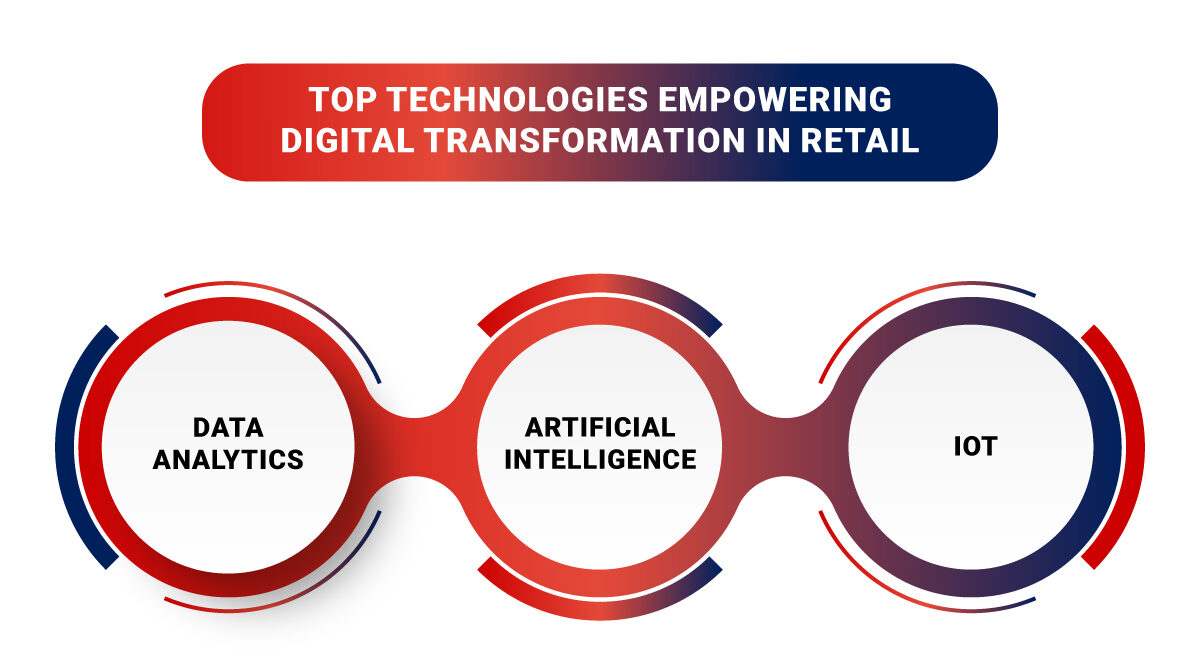
Data Analytics
As the retail landscape becomes more competitive, optimizing business processes to harness the full potential of enterprise data becomes even more critical. With the help of business intelligence in retail industry, businesses can find actionable insights, track sales forecasts, identify new products, and even predict future demand. Modern data analytics also helps e-commerce and retailers with effective product placement by heat-mapping customers.
Artificial Intelligence
In an age where consumers demand more personalized offers & products, artificial intelligence gives retailers the power to deliver on customer expectations. It leverages customer intelligence and behavior analytics to study market demographics to improve service.
IoT
In a report by Grand View Research, the global spend of IoT in retail is expected to touch $297.44 billion by 2025 [2]. It will cover every aspect of retail possible. This includes supply chain, manufacturing, field service monitoring, and inventory management. Smart retailers are embracing this technology to make store experiences more interactive. Mobile devices are powered by Bluetooth Low Energy which helps with product promotions. These trends have accelerated spend on connected technologies that monitor customer behavior, products, and supply chain.
A significant transformation was brought forth by big data analytics, location-based services & mobile apps in the way retailers conduct business today.
Key Considerations for a Successful Retail Digital Transformation Strategy
A successful retail business transformation strategy is the key to survival and growth in the retail industry. Let us explore the best practices when preparing winning retail transformation strategy.
Build a Digital-First Business
Striking a balance between online and offline processes will help you understand consumer preferences better. It will also help to deliver the same experience whether customers prefer to shop online or in-store.
Make sure you have your eye on inventory stock levels. Ensure that your store offers in-store pickup, online shipping, and curbside pickup options. These services can be pivotal role in your success. If your budget permits, you may also explore collaborations with third-party home delivery providers as well.
Review Your Physical Store Portfolio & Define Roles for Each Location
Under unforeseen circumstances, some of your stores may have to stay shut or completely closed. Make sure you have other stores available that divert customers so that your sales do not take a hit. Analytics will help you understand customer preferences in the shut store & can help you serve shoppers better at other stores.
A Mobile-First Approach for a Holistic Customer Journey
For a change, treat yourself like a customer and understand how shoppers would engage. Customers like being informed about product offers, details of a shipped product or if a product is ready for pick-up. A mobile app gives you the power to engage with shoppers at every stage.
Digital transformation in Retail Examples
Now that you understand the strategy to implement, let’s look at some real-life examples. These insights provide valuable information on how major brands have utilized advanced technologies to elevate their businesses. The adoption of such technologies was well underway even before the pandemic, and they have notably contributed to enhancing the experiential shopping journey.
Here are some ways you can plan your digital-first journey:
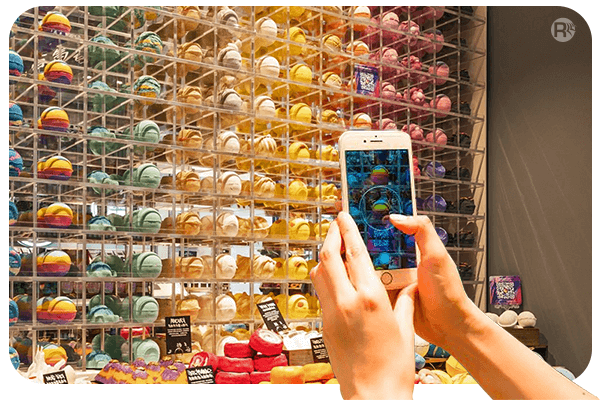
App-First Store
One of the biggest British cosmetic retailers that set up shop in Japan is now an abode for shoppers. Here customers engage in in-store activity and get information about all products without reaching out to the staff. The store sells bath bombs of all shapes, sizes, and colors. Shoppers also get to choose from a variety of fragrances. By scanning a bath bomb, customers receive more information about the product like its name, benefits, ingredients, properties, and visuals. With a huge population of digital natives, this app took off and increased the sales of bath bombs by 30%.
The Ultimate Speed Shop
An American sports apparel & equipment giant set up a flagship store for customers who do not particularly enjoy physical shopping. It unlocked convenience and transformed customer experience all through a mobile app. With this feature on the app, customers can reserve shoes online that they can try at the store.
The studio provides shoppers personalized lockers which they can unlock with their smartphone. Of course, they have a mobile checkout system where shoppers do not have to stand in a queue. This store attracted flocks of tourists and fans of the brand who tapped into this new experience. This app was a success and the sales shot up by 40%.
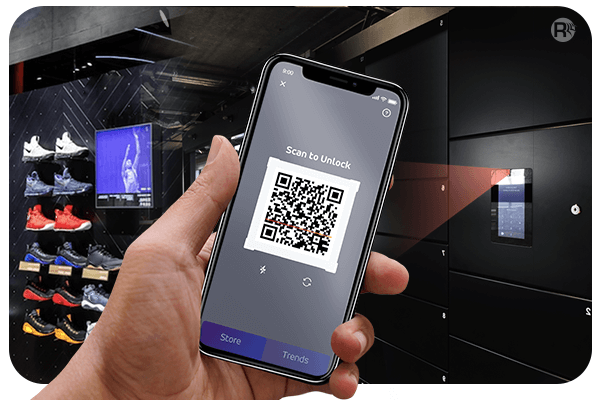
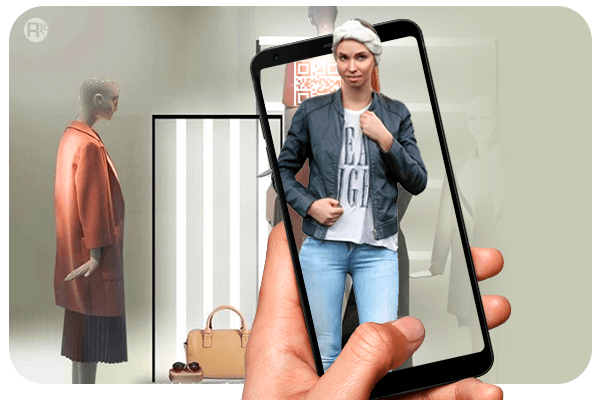
AR Window Displays
A Spanish apparel giant integrated AR technology into its stores with in-store AR zones and exterior window displays. It brought fashion to the floors of select stores. Customers were asked to stand in front of a specific area where they would use their phone as a lens in front of a sensor. Models would then flash on their phone screens who wore the latest collection. It would give shoppers styling tips and a chance to explore new styles that they never did in the past. Even their eCommerce shoppers got the chance to explore the newly rolled out AR technology. With enhanced customer engagement, this ‘shop-the-look’ feature resulted in 20% increased sales.
Why Choose Rishabh Software as Your Trusted Partner in Retail Digital Transformation?
As a digital transformation company, we have a proven track record of helping retailers worldwide to achieve their digital transformation goals. We can help you implement various digital technologies such as omnichannel commerce, mobile applications, and chatbots to enhance the customer experience across every touchpoint. Connect with us to build one-of-a-kind custom retail software development solution to transform your business inside and out.
Frequently Asked Questions
Q: How can I use data analytics and AI to improve my retail business?
A: Here are some ways to use AI and Data technologies to improve customer experience and grow your overall retail business operations.
- Customer Insights: These disruptive technologies help gather and analyze customer data to understand preferences, buying patterns, and demographic information. This helps in personalized marketing and product recommendations.
- Inventory Management: AI can forecast demand, optimize inventory levels, and minimize overstocking or understocking.
- Pricing Strategies: Utilize data analytics to set dynamic pricing based on market trends and competition, ensuring competitiveness and profitability.
- Supply Chain Optimization: AI can enhance supply chain efficiency, providing real-time tracking, reducing costs, and ensuring timely deliveries.
- Chatbots and Customer Service: Implement AI-powered chatbots for real-time customer support 24×7, answering queries and resolving issues.
- Loss Prevention: Use AI for video surveillance to identify theft and prevent shrinkage.
- Marketing and Advertising: You can efficiently optimize marketing campaigns by targeting specific customer segments with personalized content and recommendations.
Q: What are the advantages of using blockchain in retail?
A: Blockchain technology offers several benefits for the retail industry.
- Supply Chain Transparency: Blockchain provides an immutable ledger for tracking the origin and journey of products, ensuring authenticity, and reducing fraud.
- Enhanced Security: Data on a blockchain is highly secure due to its decentralized nature, reducing the risk of data breaches and fraud.
- Smart Contracts: Automate agreements and transactions, reducing administrative tasks and human error.
- Customer Trust: With transparent supply chains and product traceability, blockchain technology helps retail businesses build customer trust.
- Reduced Counterfeiting: Blockchain technology serves as a secure tracking system that helps verify the authenticity of products, combating counterfeit goods. With blockchain, product endpoints remain unchangeable, enabling customers to easily verify authenticity by checking if the item’s destination aligns with their purchase location.
- Efficient Inventory Management: Real-time tracking and authentication improve inventory management and reduce overstock or understock issues.
Q: How can I automate my retail operations?
A: Automation can streamline various aspects of retail operations:
- Point of Sale (POS) Systems: Use automated POS systems for quick and accurate transactions.
- Inventory Management: Implement systems that automatically update inventory levels when products are sold.
- Order Processing: Automate order fulfillment processes, from order placement to shipping.
- Chatbots: Using AI chatbots, retailers can easily handle customer inquiries and support.
- Marketing Automation: Utilize marketing automation tools for email marketing, customer segmentation, and personalized marketing campaigns.
- Supply Chain Automation: Automate supply chain processes, such as demand forecasting and order replenishment.
Q: What are the pillars of digital transformation in the retail industry?
A: Digital transformation in retail relies on several key pillars. Here are some key pillars.
- Customer-Centric Approach: You should put customers at the center of your strategy to provide personalized experiences and increase the retail store digital transformation outcomes.
- Data-Driven Insights: Use technologies and data to make informed decisions, improve operations, and predict trends for the growth of your retail business.
- Technology Integration: Integrate digital tools and technologies seamlessly into your operations.
- Agile Operations: Be adaptable and responsive to market changes, enabling quick decision-making.
- Employee Empowerment: Train and empower your staff to use digital tools effectively.
Footnotes:
1. https://www.mordorintelligence.com/industry-reports/digital-transformation-market-in-retail
2. https://www.grandviewresearch.com/press-release/global-internet-of-things-iot-retail-market
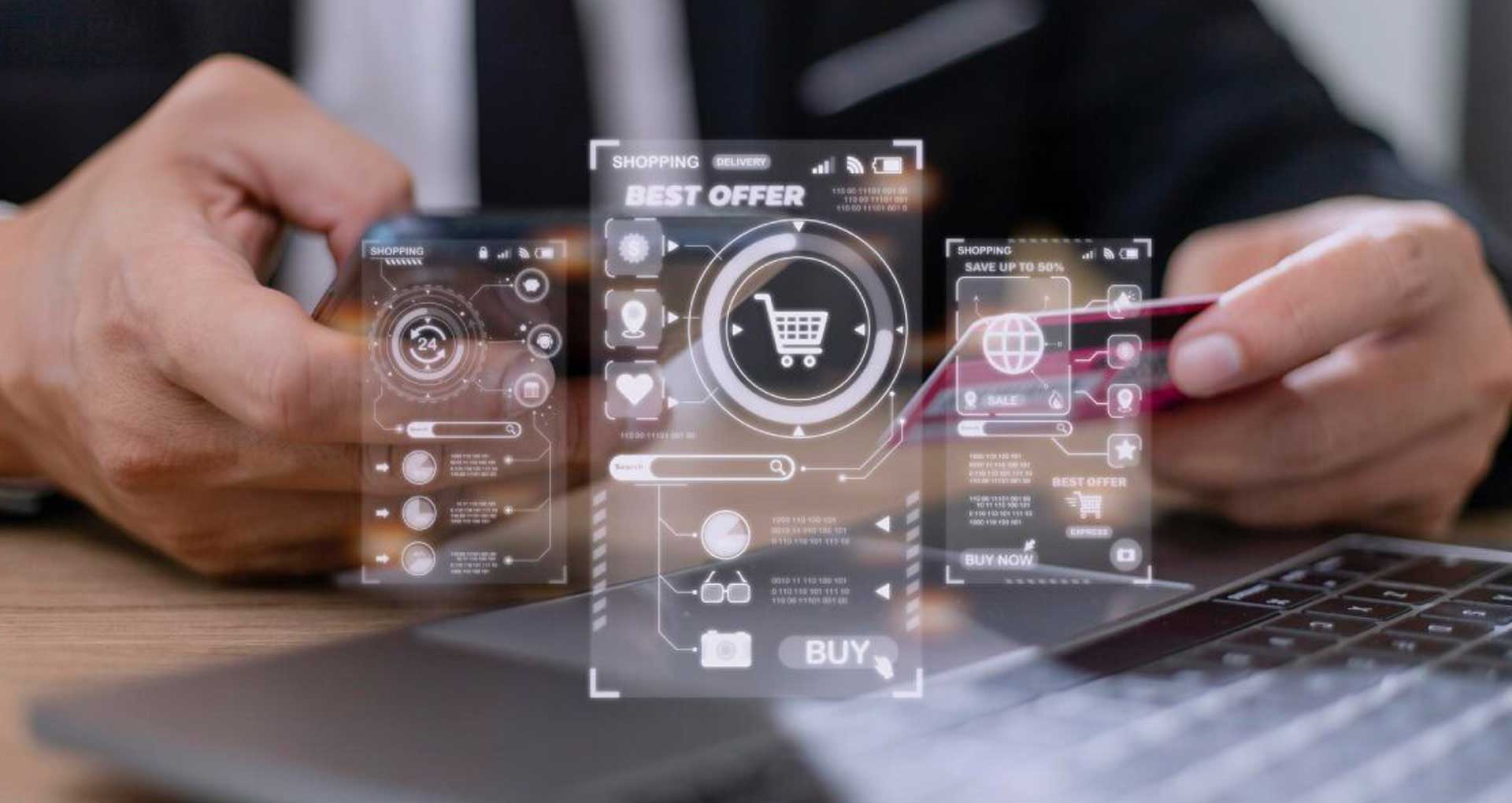










 30 Min
30 Min


